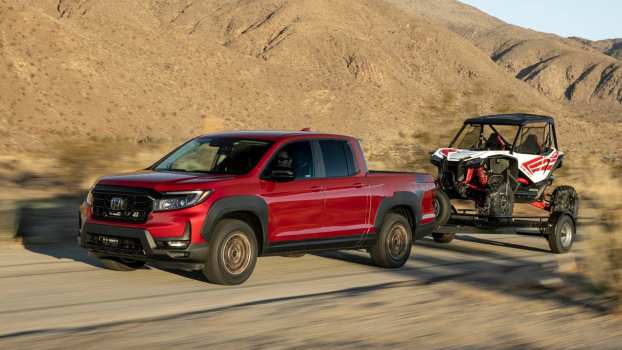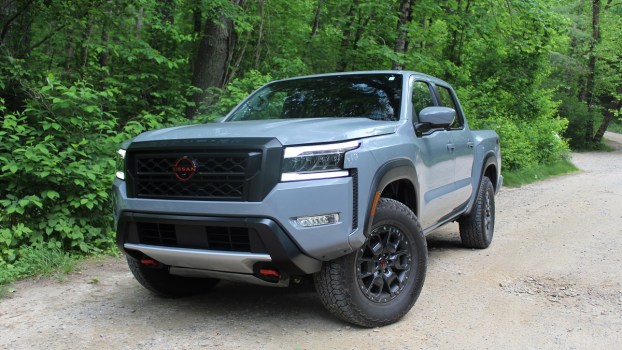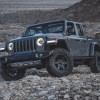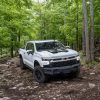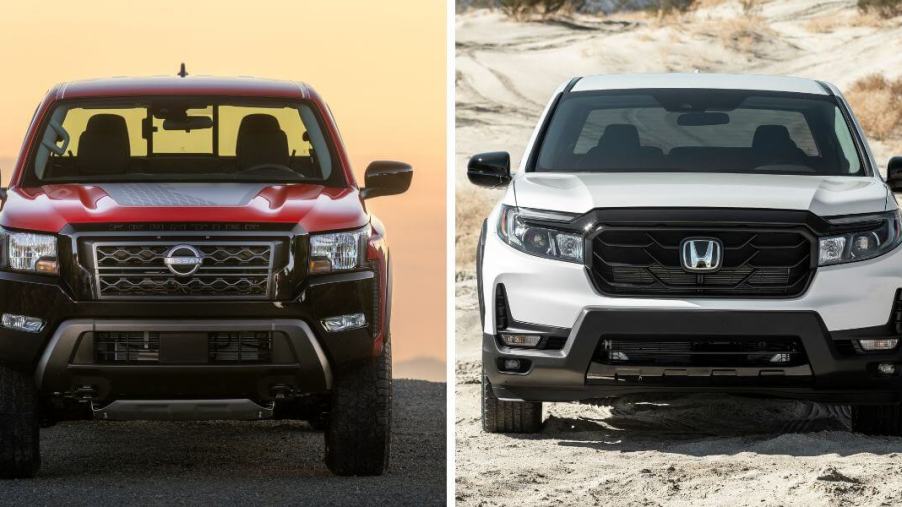
2024 Nissan Frontier vs. 2023 Honda Ridgeline: A Better Truck vs. A Better Vehicle
Modern pickup trucks offer all-around utility for everyday drivers. While some models have rugged personalities, others are more on-road-oriented. That’s very much the case when comparing the Nissan Frontier to the Honda Ridgeline.
The new Nissan Frontier offers a no-thrills but satisfying and affordable small truck option. That’s in contrast to the Honda Ridgeline’s unibody design, which isn’t great at being a traditional truck but excels everywhere else.
Let’s explore both pickups and why one is a better truck and the other a superior all-around vehicle.
2024 Nissan Frontier vs. 2023 Honda Ridgeline
From the outside, the Nissan Frontier and Honda Ridgeline may look similar. They both have good ground clearance, a pickup cab, and a rear bed. However, under the surface, they’re quite different. Here’s how.
The 2024 Nissan Frontier (MSRP $29,770) is pure pickup. With a traditional body-on-frame construction, it has the brawny capability trucks are known for. Still, that comes at a cost. With a rear leaf spring suspension and a live axle, the Frontier doesn’t have the smooth, pleasant ride of a car. However, for some, that’s OK.
The rest of the spec sheet shows solid equipment. As noted by Edmunds, there’s a 3.8-liter DOHC V6 with 310 hp and 281 lb-ft of torque routed through a nine-speed auto. 2WD is standard and 4WD optional. A two-door King Cab is standard, or buyers can add a four-door Crew Cab. Buyers can also select from a 73.3-inch long bed or a 58.9-inch or 59.5-inch short bed.
The Frontier’s interior is spartan and functional, with standard equipment like durable cloth trim and manually adjustable seats. Air conditioning keeps things cool in the summer. An 8.0-inch touchscreen infotainment system includes Apple CarPlay and Android Auto.
On the other hand, the 2023 Honda Ridgeline (MSRP $38,800) is more of a car in pickup clothing. Built on a unibody platform with four-wheel independent suspension, the Ridgeline exhibits car-like ride and handling.
Under the hood is a 3.5-liter SOHC V6 with 280 hp and 262 lb-ft of torque. A nine-speed auto handles gear changes, and standard AWD offers all-conditions traction. A spacious four-door cab is standard, and a 64-inch bed includes an in-bed trunk and dual-action tailgate.
Inside, the Honda has modern comfort and convenience. Rear passengers get best-in-class room. Tri-zone automatic climate control keeps everyone comfortable. The infotainment system includes an 8-inch touchscreen, Apple CarPlay, and Android Auto.
Why the Nissan Frontier is a better truck than the Ridgeline
Some people need a sturdy truck for big payloads and rugged terrain. For those, the Nissan Frontier comes out ahead of the Honda Ridgeline. Here’s why.
Body-on-frame construction provides the stout performance needed for challenging tasks. The Frontier’s full-length, boxed ladder frame, along with rear leaf springs and a Dana axle, is made for demanding conditions, whether work or play.
The Nissan also has more standard horsepower and torque than the Honda. That’s vital when towing a trailer or carrying heavy equipment. The Frontier can tow more than 6,000 lbs, while the Ridgeline can haul 5,000 lbs.
While it might seem like a small detail, the Frontier also has a larger fuel tank (21 gallons) than the Ridgeline (19.5 gallons). That may prove useful when far from home or in demanding situations.
Additionally, Frontier buyers have more options to pick and choose trims and add-ons for a pickup like nothing else on the road. From the basic King Cab S trim to the retro-inspired Hardbody Edition, the Frontier has a model for everyone. Not to mention, it’s a pickup with traditional rugged looks.
Beyond that, Car and Driver found the new Frontier the best version so far, with a reasonable price, a quality interior, and a smooth engine.
Why the Honda Ridgeline is a better overall vehicle than the Frontier
Traditional pickup trucks are cool. However, the bumpy ride and subpar fuel economy can be a burden after a while. That’s why the Honda Ridgeline’s unibody build and efficient powertrain make it an excellent all-arounder.
The Ridgeline shares its unibody platform with the Pilot SUV. That gives it pleasant performance on grocery runs and highway trips, though it detracts from off-road capabilities. Still, for many, that’s a worthy trade-off. And with standard AWD, the Ridgeline’s plenty capable in inclement weather or on dirt roads.
The comfortable theme continues inside, where the Honda’s quiet cabin makes every trip a little easier. Compared to the Frontier, the Ridgeline has more headroom/legroom, standard seating capacity, and more cargo space.
Additionally, the Honda also comes out ahead in payload capacity for everyday utility that’s hard to match. That’s especially useful, as most non-truck owners prefer using the rear bed to towing a trailer.
The Nissan Frontier and Honda Ridgeline offer contrasting solutions for today’s pickup buyers. While the Nissan has a traditional build and athletic capability, it falls behind in ride, handling, and everyday comfort. On the other hand, the Honda still has commendable utility, yet its improved dynamics and posh cabin make it the better daily driver. For those OK with a traditional pickup’s pluses and minuses, the Frontier is a solid pick. But for a more versatile ride, the Ridgeline makes sense.
